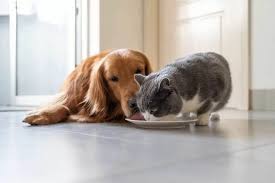As pet owners, ensuring the health and well-being of our furry friends is a top priority. A common question Can Dogs Eat Cat Food that arises in households with both dogs and cats is whether dogs can eat cat food. Understanding the differences between dog and cat nutrition is crucial for making informed decisions about your pets’ diets. This comprehensive guide explores the nutritional needs of dogs and cats, the potential risks of feeding cat food to dogs, and expert recommendations on maintaining a balanced diet for your canine companion.

Can Dogs Eat Cat Food?
1 .Understand Nutritional Needs
To understand whether dogs can eat cat food, it’s essential to first grasp the distinct nutritional requirements of dogs and cats.
Nutritional Needs of Dogs
Dogs are omnivores, meaning their diet can include a variety of food sources, including meat, grains, and vegetables. Here are the key components of a dog’s diet:
- Protein: Dogs require protein for muscle development and repair. Protein should come from high-quality animal sources like chicken, beef, and fish.
- Fats: Essential for energy, skin health, and coat condition. Omega-3 and omega-6 fatty acids are particularly.
- Carbohydrates: Provide energy and fiber. Whole grains, fruits, and vegetables are good sources for them.
- Vitamins and Minerals: Essential for overall health, immune function, and bone development. Dogs need a balanced intake of vitamins A, D, E, and K, as well as minerals like calcium and phosphorus.
- Water: Vital for hydration and bodily functions. Dogs should always have access to fresh, clean water.
Nutritional Needs of Cats
Cats ,their diet must consist primarily of meat. Their nutritional needs are more specific than those of dogs:
- Protein: Cats require a higher protein intake than dogs its natural. Animal-based proteins like chicken, beef, and fish are crucial.
- Taurine: An essential amino acid for cats, found in animal tissues. A deficiency can lead to serious health issues.
- Arachidonic Acid: A type of fatty acid found in animal fats, necessary for skin health, coat quality, and reproductive function.
- Vitamin A: Cats need preformed vitamin A from animal sources, as they cannot convert beta-carotene from plants into vitamin A.
- Vitamin B: Important for metabolism and energy production.
- Water: Cats often have a low thirst drive and rely on their diet to provide hydration. Wet food can help meet their water needs.
2. Differences Between Dog and Cat Food
Given the different nutritional requirements, commercial dog and cat foods are formulated differently. Here are some key distinctions:
- Protein Content: Cat food typically has higher protein levels to meet their dietary needs.
- Fat Content: Cat food often contains more fats, including essential fatty acids like arachidonic acid.
- Taurine: Cat food is supplemented with taurine, an amino acid critical for cats but not essential for dogs.
- Calorie Density: Cat food is usually more calorie-dense due to higher fat and protein content.
- Flavor and Palatability: Cat food is often more flavorful to entice picky eaters, which can make it more appealing to dogs as well.
Can Dogs Eat Cat Food?
Now that we understand the nutritional differences, let’s address whether it’s safe for dogs to eat cat food.
Occasional Consumption
An occasional small amount of cat food is unlikely to harm a dog. If your dog sneaks a bite of cat food every now and then, it’s generally not a cause for concern. However regular part of their diet.
Potential Risks of Regular Consumption
Can Dogs Eat Cat Food Feeding your dog cat food regularly can lead to several health issues due to the imbalance of nutrients. Here are some potential risks:
1. Protein Overload
Cat food contains higher levels of protein than dog food. While dogs need protein, excessive amounts can strain their kidneys and liver, potentially leading to health problems over time.
2. Obesity
The higher fat content and calorie density of cat food can contribute to weight gain and obesity in dogs, particularly if they are not very active. Obesity can lead to a range of health issues, including diabetes, joint problems, and heart disease.
3. Nutrient Imbalance
Dog food is provide a balanced diet for dogs. Regularly eating cat food can lead to an imbalance of essential nutrients. For example, cat food lacks adequate levels of certain vitamins and minerals that dogs need, such as vitamin E and zinc.
4. Gastrointestinal Issues
The richer, fattier content of cat food can cause digestive upset in dogs, leading to symptoms such as diarrhea, vomiting, and gas.
5. Pancreatitis
The high fat content in cat food can trigger pancreatitis in dogs, a painful and potentially life-threatening condition where the pancreas becomes inflamed.
Expert Recommendations
Veterinarians and pet nutrition experts generally advise against feeding cat food to dogs. Here are some guidelines to ensure your dog receives a balanced and healthy diet:
1. Stick to Dog Food
Feed your dog a high-quality commercial dog food that meets the nutritional standards set by organizations like the Association of American Feed Control Officials (AAFCO). This ensures your dog gets all the necessary nutrients in the right proportions.
2. Monitor Food Intake
Keep cat food out of reach of your dog to prevent them from sneaking bites. Feed your pets in separate areas and remove any leftover food promptly.
3. Address Picky Eating
If your dog is drawn to cat food due to its stronger smell and flavor, consider switching to a more palatable dog food. There are many high-quality dog foods available with various flavors to satisfy even the pickiest eaters.
4. Consult Your Veterinarian
If you have concerns about your dog’s diet or if they have specific health issues, consult your veterinarian for personalized advice. They can recommend suitable food options and supplements if necessary.
5. Provide Balanced Treats
Instead of allowing your dog to eat cat food as a treat, offer them dog-specific treats that are formulated to be healthy and balanced. Look for treats made with high-quality ingredients and avoid those with excessive fillers or artificial additives.
Starting Care for Dogs
Taking care of your dog’s diet and overall well-being involves several important steps:
1. Regular Veterinary Check-Ups
Schedule regular check-ups with your veterinarian to monitor your dog’s health, catch any potential issues early, and get professional dietary advice.
2. Proper Nutrition
Ensure your dog foo is eating a balanced diet appropriate for their age, size, and activity level. Choose high-quality commercial dog food and avoid feeding them table scraps or human food.
3. Exercise
Provide your dog food with regular exercise to maintain a healthy weight, improve cardiovascular health, and prevent obesity. Tailor the exercise routine to your dog’s breed and energy levels.
4. Grooming and Hygiene
Regular grooming is essential for your dog’s health and comfort. Brush their coat, clean their ears, trim their nails, and bathe them as needed to keep them clean and healthy.
5. Mental Stimulation
Dogs need mental stimulation to prevent boredom and behavioral issues. Provide toys, puzzles, and interactive activities to keep their minds engaged.
6. Socialization
Socialize your dog with other animals and people to ensure they are well-adjusted and confident. Socialization helps prevent behavioral problems and promotes overall well-being.
7. Training
Invest time in training your dog to ensure they are well-behaved and responsive to commands. Training enhances the bond between you and your dog and makes daily life easier and more enjoyable.
Conclusion
While an occasional nibble of cat food is unlikely to harm your dog, it’s important to keep cat food out of your dog’s regular diet. Dogs and cats have different nutritional needs, and feeding your dog cat food regularly can lead to various health issues, including obesity, nutrient imbalances, and gastrointestinal problems.
To ensure your dog’s health and well-being, provide them with a balanced diet formulated specifically for dogs, monitor their food intake, and consult your veterinarian for personalized advice. By following these guidelines, you can help your furry friend lead a happy, healthy life.
Sources
- American Veterinary Medical Association (AVMA)
- Association of American Feed Control Officials (AAFCO)
- PetMD, “Can Dogs Eat Cat Food?” – https://www.petmd.com/dog/nutrition/can-dogs-eat-cat-food
- VCA Hospitals, “Why Does My Dog Eat Cat Food?” – https://vcahospitals.com/know-your-pet/why-does-my-dog-eat-cat-food
- Cornell University College of Veterinary Medicine, “Feeding Your Dog: How Much, How Often & What’s Best?” – https://www.vet.cornell.edu/hospitals/companion-animal-hospital/pet-owners/pet-health-topics/feeding-your-dog




This article is a fantastic resource. Your detailed explanations and practical advice are greatly appreciated.
This is such a detailed and insightful post. I really appreciate the effort you put into explaining everything so clearly.
Thank you for this comprehensive guide. The practical tips you’ve shared are going to be very useful for my work.
The articles you write help me a lot and I like the topic
I’d like to find out more? I’d love to find out more details.
I’d like to find out more? I’d love to find out more details.